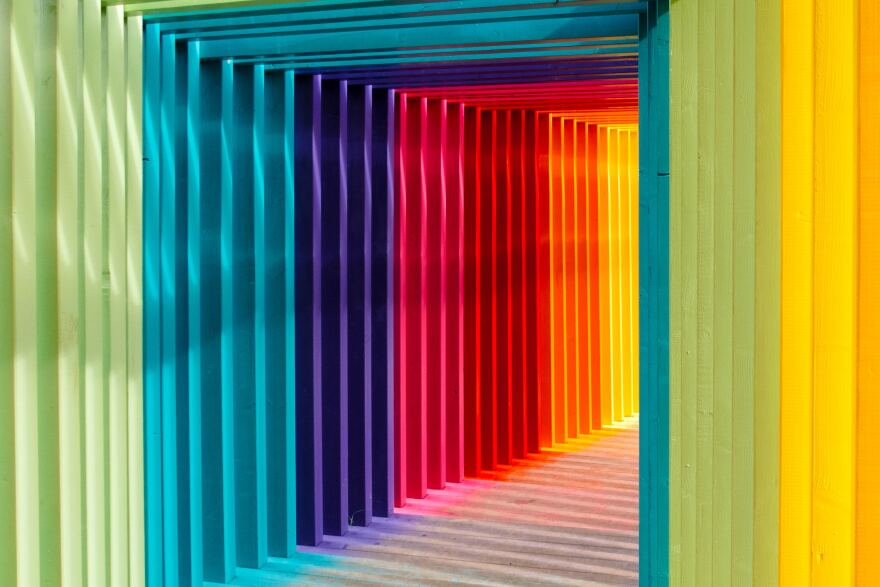What does the color blue sound like? What about orange? Is white a lighter sound than yellow? Does red sound angry, or exciting, or perhaps romantic? While it may seem funny to attach sounds to the colors of the rainbow, many composers have done just that.
Colors have been used as descriptions in music, as in the English Tudor song Greensleeves, Johann Strauss, Jr.’s Blue Danube Waltz, Nikolai Rimsky-Korsakov’s The Golden Cockerel, and George Gershwin’s Rhapsody in Blue. But there are also works in which a composer actually describes a color itself via music. Here are a few who gave it a go.
Arthur Bliss wrote his first major work for orchestra, A Colour Symphony, in 1921-22. Sir Edward Elgar had invited Bliss, and two other composers, to each write something for the 1922 Three Choirs Festival in England. The story goes that Bliss accepted the invitation, but didn’t have an idea for a theme until he read a book on heraldry, with explanations of the symbols and colors used on coats of arms. The titles of each of the four movements are colors: Purple, Red, Blue, and Green. This link to David Lloyd Jones conducting the English Northern Philharmonia in the entire symphony also allows you to click on (and hear) the individual movements.
The piece is occasionally programmed today, which might have seemed unlikely at its premiere at the Festival. Elgar was critical at the premiere, calling the work “too modern” for his taste. And critics were harsh because they said the piece sounded disjointed. It turns out that not only was there not enough rehearsal time, but several instruments had to be pulled from the performance because there just wasn’t enough space on the stage for them all.
Composer Michael Torke is a synesthete, someone who “experiences colors” when listening to music, so he comes naturally to assigning musical notes to colors. He wrote Ecstatic Orange in 1984-85, Bright Blue Music in 1985, followed by Green in 1986, Purple in 1987, and Ash in 1988. It was only after each “color piece” had been written that he thought of grouping them into his 1991 suite, Color Music. Here is David Zinman conducting the Baltimore Symphony Orchestra in "Green Music."
By the way, Torke has composed other “color” titled pieces, too, but they are not included in the casual grouping for Color Music.
Another set of colors is represented in Roger Cichy’s Colours. It’s a stirring piece for wind band that was commissioned by the Kansas State University Band and premiered in May of 1997. Cichy’s own website describes the piece as “impressionistic.” He says he wanted to convey the pigments that make up each individual color as opposed to the colors, or timbres, of music that often come to mind when someone says “musical color.” Here is a recording of the first movement, "Amber," with the Rutgers Wind Ensemble conducted by William Berz.
Cichy is an American composer and his website adds: “Why the English spelling of Colours instead of the American spelling? Most of the source books used to research the symbolism of colors used this particular spelling.”
Robert Starer was inspired to write his Sketches in Color after watching his young son, Dan, practice for his piano lessons. Set One was written in 1963. He wrote: “While looking for sounds to match colors, I observed Dan in order to discover what children like and dislike. Children do not like bombast or boredom and they see through pretentiousness much better than adults do.” The miniatures acknowledge that how a color seems musically to one person may not be the same for the next, as moods are personal, and sometimes cultural. Here is pianist Sahan Arzruni:
Starer wrote Sketches in Color, Set Two ten years later, in 1973, and between the two sets 14 colors or color combinations are explored.
Frank Ticheli’s Blue Shades incorporates many meanings of the word “blue.” The New Orleans composer said that while the work was “heavily influenced by the blues” and that “blue notes, (flatted 3rds, 5ths and 7ths)” were used, “many shades of blue are depicted from bright blue, to dark, to dirty, to hot blue.”
The University of Michigan Symphony Band is conducted by H. Robert Reynolds:
Something cool to note: Ticheli says the piece was commissioned by a consortium of 30 high school and college organizations across the country, including three here in New England: the Yale University Concert Band, the Lexington High School Symphonic Band, and the Lincoln-Sudbury Regional High School Symphonic Band.
In 1998 Belgian composer Bert Appermont wrote a piece for a leading Belgian trombonist, Ben Haemhouts. In it he explores four colors: Yellow, representing light, Red, representing courage, Blue, representing truth and peace, and Green, representing harmony. Here’s trombonist Joseph Alessi playing with the Columbus State University Wind Ensemble, conducted by Robert W. Rumbelow.
In the last two decades it has been recorded several times and is considered a contemporary virtuoso piece for trombone.
As I researched and thought about colors depicted in music, it brought home the realization that it takes a certain level of artistic genius to musically paint anything without a physical form, such as dreams, emotions, or in this case, colors. I offer a round of applause to all the composers who have done so.
CODA: Disney also tackled the idea of the music of colors in an even tougher setting in Colors of the Wind from the animated movie Pocahontas.






